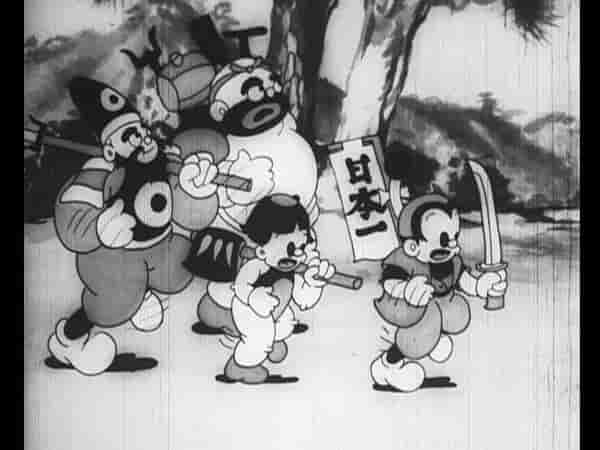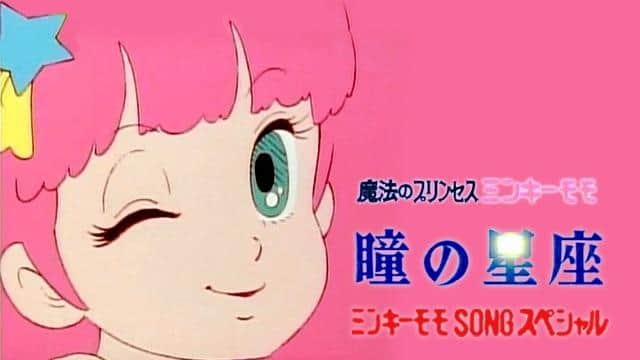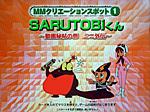The appeal and evaluation of the new Kachikachi Mountain: A deep look into the modern masterpiece

New theory on Kachikachiyama - Shinsetsu Kachikachiyama■ Public Mediatheater ■ Original MediaAnime Original ■ Release date1935 ■ Number of EpisodesEpisode 1 ■ ProductionJO Talkie Comics Club ■ Story During a musical performance at Animal Village, a rabbit girl is kidnapped by a bandit raccoon dog. The animals, including the May dolls Kintaro, Momotaro, Benkei, and Kato Kiyomasa, are called in to help, and a war breaks out between them and the raccoon dog's army. Imitating a picture book, they set the raccoon dog's back on fire and drive it away. ■ Main staffScript and illustrations by Kon Ichikawa Music by Akio Nishiyama The appeal and evaluation of the new theory of Kachikachi Mountain"New Theory of the Kachi Kachi Mountain," released in 1935, is an animated film produced by the JO Talkie Comics Division, and is still highly acclaimed for its unique story and visual expression. Although the film is based on the traditional Japanese folk tale "The Kachi Kachi Mountain," it offers a unique interpretation and development that surprised audiences at the time. The story begins with an incident that occurs during a concert at Animal Village. The story gets going with a tense scene in which a rabbit princess in the audience is kidnapped by raccoon bandits. This scene leaves a strong impression on the audience, and succeeds in increasing their immersion in the story. To save the kidnapped rabbit princess, the animals summon Japanese heroes such as May dolls Kintaro, Momotaro, Benkei, and Kato Kiyomasa. The appearance of these characters makes the story more exciting and enjoyable for both children and adults. In particular, characters such as Kintaro and Momotaro are deeply rooted in Japanese culture and history, making the audience feel familiar and nostalgic. The climax of the story depicts a scene in which the raccoon dog is defeated by setting its back on fire. This scene imitates the original picture book, but with the dynamic expression that only animation can provide. The sight of the flames covering the raccoon dog's back creates a strong visual impact and leaves a strong impression on the audience. Kon Ichikawa, who wrote the script and drew the illustrations for "New Theory of Kachikachi Mountain," was a director who would go on to have a major impact in the Japanese film industry, and his talent is on full display in this work. Kon Ichikawa's drawings realistically depict the expressions and movements of the animals, effectively conveying the tension and humor of the story. Akio Nishiyama's music also creates a dramatic effect in line with the development of the story, playing a role in enhancing the emotions of the audience. The historical background of the new theory of Kachikachi MountainThe year 1935, when "The New Theory of the Kachi Kachi Mountain" was released, was a time when the Japanese film industry was rapidly developing, and animated films played a part in that development. At the time, talkies (films with sound) had only just begun to become popular, and animated films also sought new possibilities for expression by incorporating that technology. "The New Theory of the Kachi Kachi Mountain" is one example of this, and the effective use of music and sound effects enhances the realism of the story. The 1930s was also a time when the shadow of war was beginning to flicker in Japan. Against this backdrop, "New Theory of Kachikachi Mountain" is a work that gives courage and hope to the audience through a story of animals banding together to defeat evil. In particular, the appearance of Japanese heroes such as Kintaro and Momotaro is thought to have had the effect of making the audience feel proud of Japanese traditions and culture. Evaluation and influence of the new theory of Kachikachi Mountain"The New Theory of Kachikachi Mountain" was highly praised when it was released, especially for its visual expression and storytelling. Kon Ichikawa's drawings made a strong impression on audiences, depicting the animals' expressions and movements realistically. Akio Nishiyama's music also played a role in creating a dramatic effect in line with the development of the story, enhancing the audience's emotions. Although this work was based on the Japanese folk tale "Kachi Kachi Yama," it added its own unique interpretation and development, which gave a fresh surprise to the audience at the time. In particular, the appearance of Japanese heroes such as Kintaro and Momotaro is thought to have had the effect of making the audience feel proud of Japanese traditions and culture. "New Theory of Kachikachi Mountain" had a great influence on the development of Japanese animation films. In particular, Kon Ichikawa's drawing style and storytelling techniques had a great influence on later animation films. Akio Nishiyama's music also played a role in creating a dramatic effect in line with the development of the story and enhancing the emotions of the audience. Recommended points of the new theory of Kachikachiyama"The New Theory of Kachi Kachi Mountain" is a work that can be enjoyed by children and adults alike, and is especially praised for its visual expression and storytelling. In particular, the appearance of Japanese heroes such as Kintaro and Momotaro is thought to have had the effect of making the audience feel proud of Japanese traditions and culture. Kon Ichikawa's drawing style and storytelling techniques also had a significant influence on later animated films. Furthermore, Akio Nishiyama's music also played a role in creating dramatic effects in line with the development of the story, enhancing the emotions of the audience. Although this work was based on the Japanese folk tale "Kachi Kachi Yama," it added its own unique interpretation and development, which gave a fresh surprise to the audience at the time. In particular, the appearance of Japanese heroes such as Kintaro and Momotaro is thought to have had the effect of making the audience feel proud of Japanese traditions and culture. Kon Ichikawa's drawing style and storytelling techniques also had a great influence on later animated films. Furthermore, Akio Nishiyama's music also played a role in creating dramatic effects in line with the development of the story, enhancing the emotions of the audience. "New Theory of Kachi Kachi Mountain" is especially praised for its visual expression and storytelling. In particular, the appearance of Japanese heroes such as Kintaro and Momotaro is thought to have had the effect of making the audience feel proud of Japanese traditions and culture. Kon Ichikawa's drawing style and storytelling techniques also had a significant influence on later animated films. Furthermore, Akio Nishiyama's music also played a role in creating dramatic effects and enhancing the audience's emotions as the story unfolded. Although this work was based on the Japanese folk tale "Kachi Kachi Yama," it added its own unique interpretation and development, which gave a fresh surprise to the audience at the time. In particular, the appearance of Japanese heroes such as Kintaro and Momotaro is thought to have had the effect of making the audience feel proud of Japanese traditions and culture. Kon Ichikawa's drawing style and storytelling techniques also had a great influence on later animated films. Furthermore, Akio Nishiyama's music also played a role in creating dramatic effects in line with the development of the story, enhancing the emotions of the audience. "New Theory of Kachi Kachi Mountain" is especially praised for its visual expression and storytelling. In particular, the appearance of Japanese heroes such as Kintaro and Momotaro is thought to have had the effect of making the audience feel proud of Japanese traditions and culture. Kon Ichikawa's drawing style and storytelling techniques also had a significant influence on later animated films. Furthermore, Akio Nishiyama's music also played a role in creating dramatic effects and enhancing the audience's emotions as the story unfolded. Although this work was based on the Japanese folk tale "Kachi Kachi Yama," it added its own unique interpretation and development, which gave a fresh surprise to the audience at the time. In particular, the appearance of Japanese heroes such as Kintaro and Momotaro is thought to have had the effect of making the audience feel proud of Japanese traditions and culture. Kon Ichikawa's drawing style and storytelling techniques also had a great influence on later animated films. Furthermore, Akio Nishiyama's music also played a role in creating dramatic effects in line with the development of the story, enhancing the emotions of the audience. "New Theory of Kachi Kachi Mountain" is especially praised for its visual expression and storytelling. In particular, the appearance of Japanese heroes such as Kintaro and Momotaro is thought to have had the effect of making the audience feel proud of Japanese traditions and culture. Kon Ichikawa's drawing style and storytelling techniques also had a significant influence on later animated films. Furthermore, Akio Nishiyama's music also played a role in creating dramatic effects and enhancing the audience's emotions as the story unfolded. Although this work was based on the Japanese folk tale "Kachi Kachi Yama," it added its own unique interpretation and development, which gave a fresh surprise to the audience at the time. In particular, the appearance of Japanese heroes such as Kintaro and Momotaro is thought to have had the effect of making the audience feel proud of Japanese traditions and culture. Kon Ichikawa's drawing style and storytelling techniques also had a great influence on later animated films. Furthermore, Akio Nishiyama's music also played a role in creating dramatic effects in line with the development of the story, enhancing the emotions of the audience. |
<<: Tarzan's Monster Hunt: A thorough review of the fascinating characters and depth of the story
>>: Dan'emon Hanawa's Monster Hunt: A fascinating story and in-depth character exploration
Recommend
Netflix's original stop-motion animation "Lila Bear and the Amusement Park" reveals the new adventure of the lazy bear
Today, October 27, Netflix announced that the seq...
A thorough review of Ninja Hattori-kun's "Ninja Hometown Mission"!
"Ninja Hattori-kun: The Great Ninja Hometown...
Ryan Reynolds: I'm definitely not in Doctor Strange 2
Marvel released a new trailer for Doctor Strange ...
The live-action movie of the popular Japanese manga "My Hero" was released on Women's Day
"My Hero", which has been serialized in...
Doraemon's original voice actor Kosei Tomita dies at 84
According to Japanese media reports today on Octo...
Harry Potter spin-off "House of Gaunt: The Origin of Voldemort" reveals final poster and is set to be released on May 29
The Harry Potter series spin-off short film "...
"Maleficent 2" first released three major character posters, Jolie's aura is compelling
Disney's live-action film "Maleficent: M...
"The Captain" - Special Edition of Behind-the-scenes Training for Flight Attendants - Even big-name stars have to learn
Today (September 5), "The Captain" star...
GSC launches two clay figures of "Cosmic Giants": "He-Man" and "Skull King"
Today (December 24), Good Smile Company GSC annou...
The appeal and evaluation of "Shadow Skill Season 1": The pinnacle of fighting action
Shadow Skill SHADOW SKILL [1st Season] - Detailed...
The "Wonka" movie "Chocolate Dream" version trailer will be released on December 8
On November 13, Warner Bros. released the "C...
Pumpkin Man: A thorough analysis of the appeal of Minna no Uta
Pumpkin Man - Everyone's Song Masterpiece &qu...
The appeal and reviews of "Bush Babies": A moving story and deep characters
Bush Babies - A moving story of journey and growt...
Salaryman Minimini Strategy: The ultimate entertainment for working adults, bringing healing and laughter
Salaryman Mini-Mini Strategy - The charm of nosta...
Review of "Requiem of the Rose King": A fusion of epic story and beautiful visuals
Detailed review and recommendation of The Requiem...









